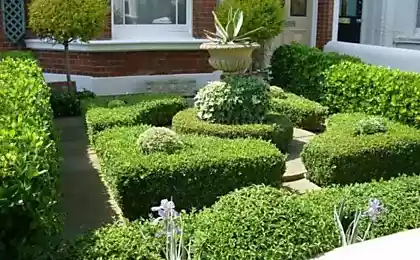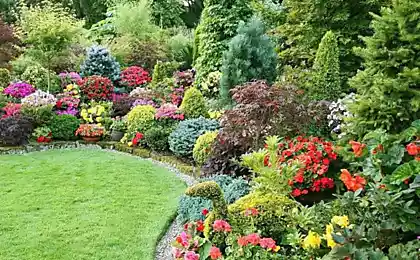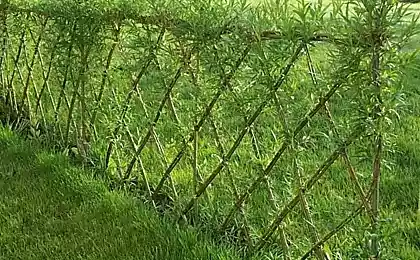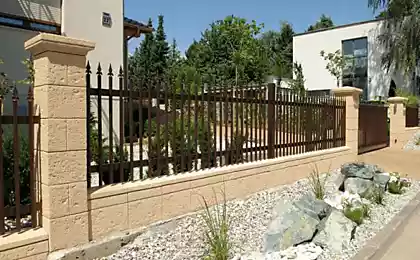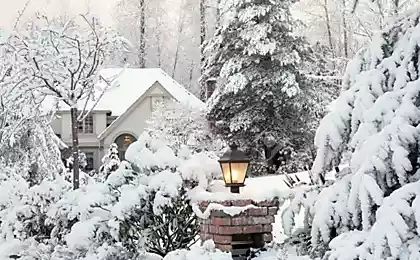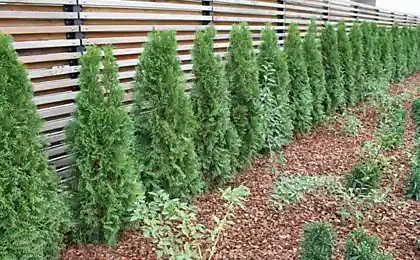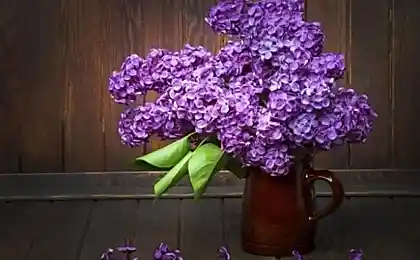1132
The choice of shrubs for hedges luxury
Varieties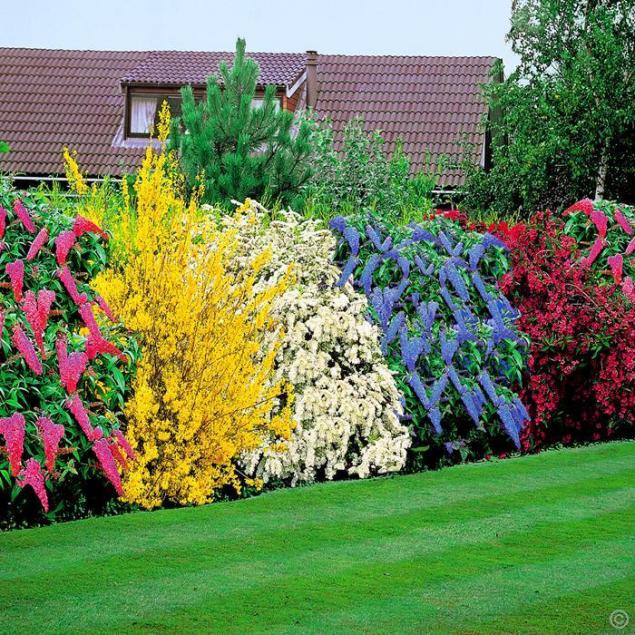
The choice of the breed of shrub or treeAs already mentioned, the choice of shrub or tree from which made the hedges in the country, should be approached with special attention.


Hedge of Spiraea vanhoutte
The hedges in the garden plays an important role and performs several functions. It forms the boundary of the garden, covering it live ring, protects from cold in winter, and in summer from the drying winds. Inside this ring creates a moist, warm and less prone to strong fluctuations in microclimate. A hedge is a haven for beneficial insects and birds, where they find food and shelter. In addition, sheltering the garden from prying eyes, creating a cozy home atmosphere within its green ring protects the garden from dust, noise and fumes, when there is a road.
But if you pick up the right flowering and fruiting types of shrubs for your hedge, it will provide you with valuable berries and delight the eye with bright colours of their flowers. Abundant flowering, accompanied by the release of aromatic substances, revitalizes the atmosphere; when the time comes for flowering lilac, Jasmine, rose, small garden is transformed into a fragrant Paradise.
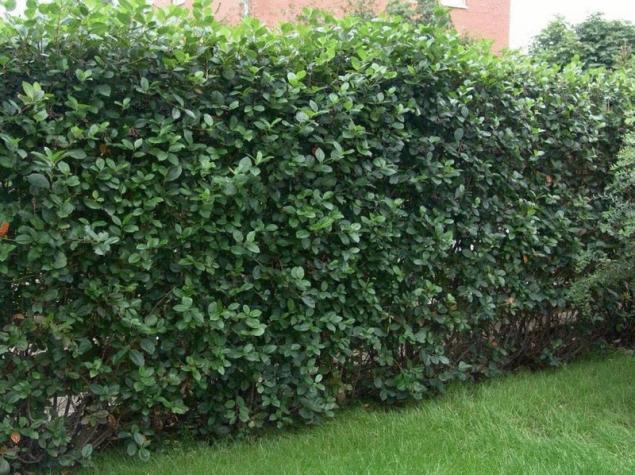
Hedge of Aronia
Planning the planting of hedges, it is necessary to consider the particular location of your garden, or hedges instead of your assistant will turn into the enemy. For example, if the site is located in the lower part of the slope, the hedge planted at the bottom end of the plot across the slope, would hold down flowing cold air, as if forming a pocket in which the cold air will linger. Conversely, planting of shrubs along the top border of the plot will stall and dissipate the cold stream.
The choice of species for hedges and hedges are quite diverse. If you don't want to spend a lot of space and I'm afraid of shading, you should create a sheared hedge, from which you will get a tight fence of the desired height and width. Typically, the height of such fence does not exceed 1.8-2.0 m in order not to complicate the pruning to reduce shading. There are a number of shrubs and even tree species can withstand pruning well.

A hedge of barberry
Among them in the first place is ordinary Privet that retain green foliage until late autumn. Next, you can call the barberry, honeysuckle and forest, spirea, cotoneaster, dogwood, Saskatoon, yellow acacia, Golden currant. Trees respond well to shearing spruce, juniper virgin, American arborvitae, beech, elm, lime.
If there is enough space, then make a fence of free-growing shrubs. At the external border of the garden, plant taller species — hazel, Jasmine, lilac, sumac, hawthorn, chokeberry (Aronia), Kalina. Their height can reach 3-4 m. For a lower fence height of 1-2 m using a cotoneaster, Golden currant, snowberry, wild rose, Spiraea. When the plants fully grow, the width of these hedges is 1.5-2.5 m. All these rocks are fairly resistant to frost and tolerate temperatures to -25 °C.

A hedge of Privet
Breed flowering shrubs it is advisable to choose in such a way that their successive flowering lasted as long as possible. Peak flowering usually occurs in spring, when putting forth their flowers Saskatoon canadian, ornamental quince, barberry, triloba Prunus, dogwood, cotoneaster, forsythia, plum, cherry felt, Golden currant, spirea, lilac, weigelia. In early summer bloom Kerry, kolkwitzia, Jasmine, rose, Golden rain, spirea in late summer — buddleia, weigelia (some types of repeat flowering), hibiscus syriacus.

Along the wooden fence not less than 1.5 m or on the boundary with the adjacent site are usually planted berry bushes: currants, gooseberries, blackberries, raspberries.

Hedge of cotoneaster
Planting shrubs is usually produced in late autumn. To do this, dig up a strip across the length of the future fence width of 1 m and a depth of 30 cm at the same time make organic fertilizer. The underlying layer of the soil is not dug up, loosened with a shovel. Landing in the broad strip of loosened earth gives more room for the root system than planting in individual holes. The soil abundantly watered before planting and after. If the roots after transporting the dried, they are immersed for 1-2 days in water. The stage is set for 2-3 months before planting. After planting the soil mulch.
Free-growing shrubs usually are planted in single rows, on the slopes of the number of rows can be increased. The average distance in the range of 1-1. 2 m tall species — 1,5-2 m, distance from the boundaries of the area of at least 1 m is Recommended to plant different types interspersed, alternating tall and low-growing. After planting the shoots are cut two-thirds their length.
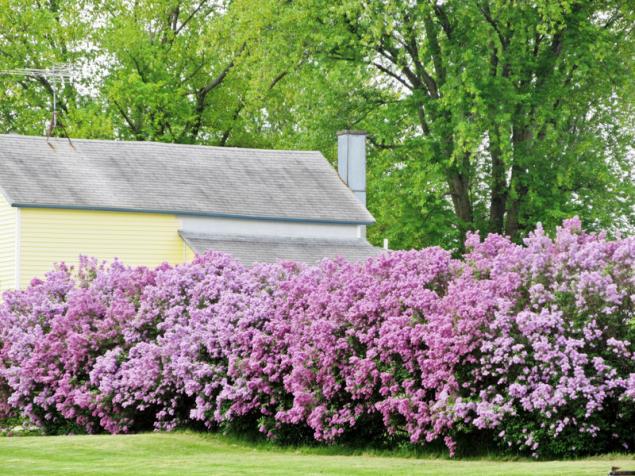
A hedge of lilac
In the first two or three years until the plants will not root as it should, the hedge requires constant care, which includes watering and weeding. In the future, competition of weeds are not afraid of big bushes, but necessary to ensure that weeds, especially perennial, does not pass out on the beds.

A hedge of currant Golden
Hedge, even free growing, requires constant attention. The main thing — not to allow it to grow very wide and to rejuvenate the bushes so they don't denude the bottom. For lilac, Jasmine and honeysuckle rejuvenation is achieved by removing woody shoots at a height of 10-20 cm from the soil surface. Shrubs of other species of rejuvenation not tolerate.
Shrubs, flowering in spring, cut immediately after flowering, to induce abundant formation of flowering shoots the following year. Haircut to give shape to planted the hedges held several times a year. After 3 years enough one or two times a year: early June and late July — early August. Cut all the young shoots are of a thickness less than 2 cm published
Source: www.sadovoda.ru
- Low hedge reaches a maximum of one meter in height.
- The average live fence has a height of from one meter to one and a half.
- High — a height more than six feet.
- Also they are taller than a man, they often reach two meters and a half and presented in the form of a real live wall.
- In classification there is very little fencing, the growth of which reaches half a meter.

The choice of the breed of shrub or treeAs already mentioned, the choice of shrub or tree from which made the hedges in the country, should be approached with special attention.
- For fences with a height of half a meter to a meter made use of thornless plants, such as purple willow, Alpine currant, Daurian or the shrubby cinquefoil, Golden currants, pine, Western thuja. If you prefer the barbed fence of this height, it is recommended to use the ordinary barberry, Japanese quince, sea buckthorn, wild rose, pine and juniper.

- For thornless one or two metre high fences made use of yellow acacia, European spindle tree, common Privet, common honeysuckle, cotoneaster, English physocarpus, common and Hungarian lilac. Will also fit Western arborvitae, Siberian fir, Virginia juniper, Siberian, Oriental or common spruce. If you prefer a barbed fence the same height, use coniferous juniper, silver or uzkolisty sucker, Japanese quince, common barberry or Thunberg, Siberian or common hawthorn.

- To create hedges with a height of from three to five meters can be used berry Apple, rotundifolia irgu, maple Ginnala, Tatar or field maple, Western thuja, or ordinary Siberian fir, Siberian, hawthorn, cherry plum, a laxative buckthorn, uzkolisty sucker, common tern, spiky spruce and common juniper.
- For sheared high fence, the wall, fit an ordinary elm, pedunculate oak, small-leaved lime, berry tree, common spruce, Siberian or canadian fir, Siberian fir or Western arborvitae.
Hedge of Spiraea vanhoutte
The hedges in the garden plays an important role and performs several functions. It forms the boundary of the garden, covering it live ring, protects from cold in winter, and in summer from the drying winds. Inside this ring creates a moist, warm and less prone to strong fluctuations in microclimate. A hedge is a haven for beneficial insects and birds, where they find food and shelter. In addition, sheltering the garden from prying eyes, creating a cozy home atmosphere within its green ring protects the garden from dust, noise and fumes, when there is a road.
But if you pick up the right flowering and fruiting types of shrubs for your hedge, it will provide you with valuable berries and delight the eye with bright colours of their flowers. Abundant flowering, accompanied by the release of aromatic substances, revitalizes the atmosphere; when the time comes for flowering lilac, Jasmine, rose, small garden is transformed into a fragrant Paradise.

Hedge of Aronia
Planning the planting of hedges, it is necessary to consider the particular location of your garden, or hedges instead of your assistant will turn into the enemy. For example, if the site is located in the lower part of the slope, the hedge planted at the bottom end of the plot across the slope, would hold down flowing cold air, as if forming a pocket in which the cold air will linger. Conversely, planting of shrubs along the top border of the plot will stall and dissipate the cold stream.
The choice of species for hedges and hedges are quite diverse. If you don't want to spend a lot of space and I'm afraid of shading, you should create a sheared hedge, from which you will get a tight fence of the desired height and width. Typically, the height of such fence does not exceed 1.8-2.0 m in order not to complicate the pruning to reduce shading. There are a number of shrubs and even tree species can withstand pruning well.

A hedge of barberry
Among them in the first place is ordinary Privet that retain green foliage until late autumn. Next, you can call the barberry, honeysuckle and forest, spirea, cotoneaster, dogwood, Saskatoon, yellow acacia, Golden currant. Trees respond well to shearing spruce, juniper virgin, American arborvitae, beech, elm, lime.
If there is enough space, then make a fence of free-growing shrubs. At the external border of the garden, plant taller species — hazel, Jasmine, lilac, sumac, hawthorn, chokeberry (Aronia), Kalina. Their height can reach 3-4 m. For a lower fence height of 1-2 m using a cotoneaster, Golden currant, snowberry, wild rose, Spiraea. When the plants fully grow, the width of these hedges is 1.5-2.5 m. All these rocks are fairly resistant to frost and tolerate temperatures to -25 °C.

A hedge of Privet
Breed flowering shrubs it is advisable to choose in such a way that their successive flowering lasted as long as possible. Peak flowering usually occurs in spring, when putting forth their flowers Saskatoon canadian, ornamental quince, barberry, triloba Prunus, dogwood, cotoneaster, forsythia, plum, cherry felt, Golden currant, spirea, lilac, weigelia. In early summer bloom Kerry, kolkwitzia, Jasmine, rose, Golden rain, spirea in late summer — buddleia, weigelia (some types of repeat flowering), hibiscus syriacus.

Along the wooden fence not less than 1.5 m or on the boundary with the adjacent site are usually planted berry bushes: currants, gooseberries, blackberries, raspberries.

Hedge of cotoneaster
Planting shrubs is usually produced in late autumn. To do this, dig up a strip across the length of the future fence width of 1 m and a depth of 30 cm at the same time make organic fertilizer. The underlying layer of the soil is not dug up, loosened with a shovel. Landing in the broad strip of loosened earth gives more room for the root system than planting in individual holes. The soil abundantly watered before planting and after. If the roots after transporting the dried, they are immersed for 1-2 days in water. The stage is set for 2-3 months before planting. After planting the soil mulch.
Free-growing shrubs usually are planted in single rows, on the slopes of the number of rows can be increased. The average distance in the range of 1-1. 2 m tall species — 1,5-2 m, distance from the boundaries of the area of at least 1 m is Recommended to plant different types interspersed, alternating tall and low-growing. After planting the shoots are cut two-thirds their length.

A hedge of lilac
In the first two or three years until the plants will not root as it should, the hedge requires constant care, which includes watering and weeding. In the future, competition of weeds are not afraid of big bushes, but necessary to ensure that weeds, especially perennial, does not pass out on the beds.

A hedge of currant Golden
Hedge, even free growing, requires constant attention. The main thing — not to allow it to grow very wide and to rejuvenate the bushes so they don't denude the bottom. For lilac, Jasmine and honeysuckle rejuvenation is achieved by removing woody shoots at a height of 10-20 cm from the soil surface. Shrubs of other species of rejuvenation not tolerate.
Shrubs, flowering in spring, cut immediately after flowering, to induce abundant formation of flowering shoots the following year. Haircut to give shape to planted the hedges held several times a year. After 3 years enough one or two times a year: early June and late July — early August. Cut all the young shoots are of a thickness less than 2 cm published
Source: www.sadovoda.ru
3 recipe healthy bread from amaranth
How to make tea and Jerusalem artichoke syrup, a natural source of inulin




